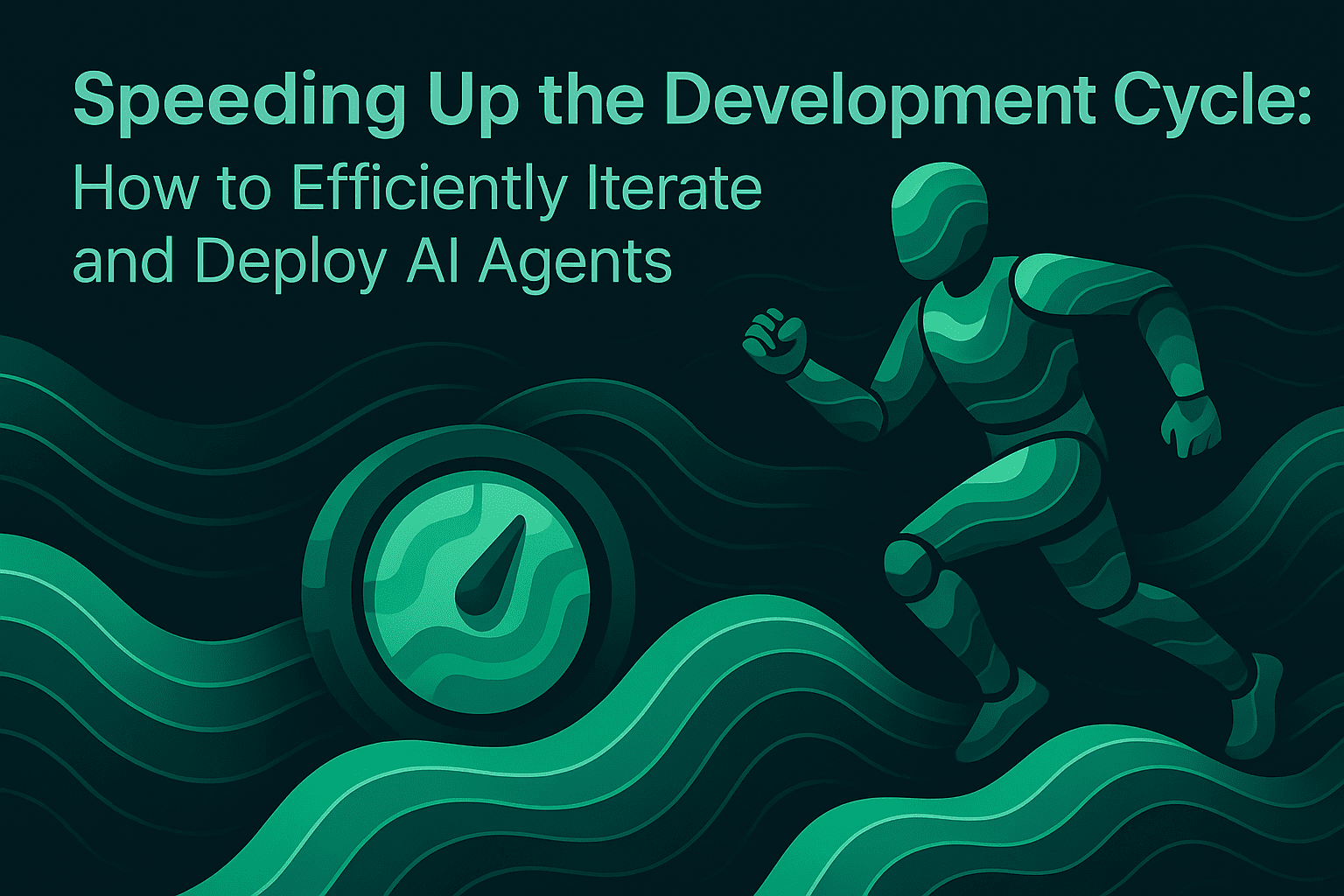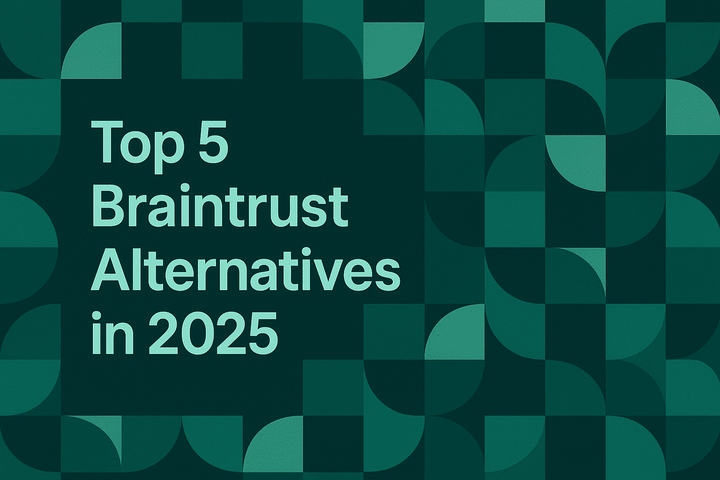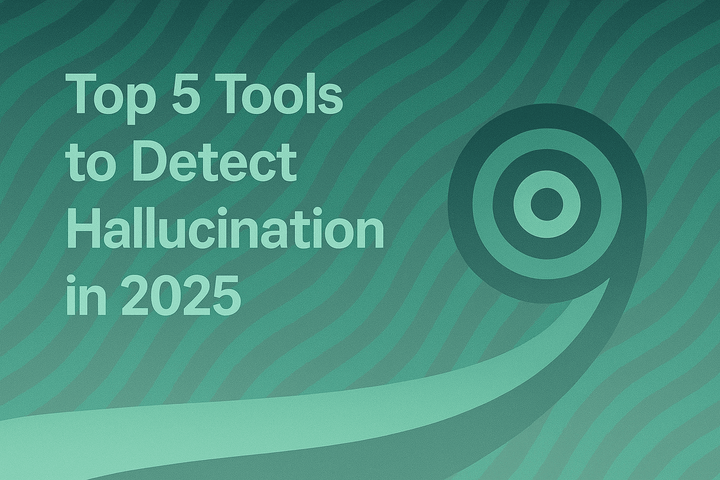Speeding Up the Development Cycle: How to Efficiently Iterate and Deploy AI Agents

TL;DR
Organizations deploying AI agents report significant gains: early adopters achieve 2x iteration speed when fine-tuning industry-specific agents, while 62% of organizations expect more than 100% ROI from agentic AI deployment. This article explores proven strategies to accelerate AI agent development through systematic experimentation, automated simulation, comprehensive evaluation frameworks, and robust observability. Teams implementing these practices reduce development cycles from months to weeks while maintaining quality and reliability in production environments.
Understanding the AI Agent Development Lifecycle Bottlenecks
Traditional software follows deterministic, rule-based patterns where the same input reliably produces the same output. AI agents, powered by large language models and written in natural language prompts, are non-deterministic and goal-based, creating unique challenges for development teams.
The shift from traditional software to AI agents introduces several critical bottlenecks. Traditional software collects user input through structured forms and fields, while agents communicate through natural language, producing a nearly infinite number of possible interactions. This complexity multiplies testing requirements exponentially. Furthermore, agents depend on LLMs that are often slow and orders of magnitude more expensive than traditional software due to model inference costs.
Development teams face three primary challenges when building AI agents: the unpredictability of LLM responses, the complexity of multi-step workflows involving tool calls and external APIs, and the difficulty of measuring quality objectively. AI agents aren't general-purpose chatbots—they are systems built for targeted, high-value tasks, requiring careful alignment between business objectives, product requirements, and technical implementation.
Modern AI engineering demands new tooling and practices specifically designed for the unique characteristics of agentic systems. Teams need platforms that support rapid prompt iteration, automated testing at scale, comprehensive observability, and continuous quality monitoring—capabilities that traditional development tools cannot provide.
Accelerating Development Through Structured Experimentation
Efficient AI agent development starts with systematic prompt engineering and experimentation workflows. Organizations must move beyond ad-hoc prompt crafting to establish repeatable processes that enable rapid iteration while maintaining quality standards.
Building a Robust Prompt Management System
Prompt management forms the foundation of efficient agent development. Teams need centralized repositories where prompts are versioned, organized, and easily accessible. This eliminates the common problem of scattered prompt definitions across codebases and enables collaboration between technical and non-technical team members.
Version control for prompts allows teams to track changes, compare performance across iterations, and roll back problematic updates quickly. When combined with deployment strategies, engineering teams can implement gradual rollouts, A/B testing, and feature flags specifically for prompt variations.
The prompt playground accelerates the initial development phase by providing an interactive environment where developers can test prompt variations against different models and parameters. This reduces the feedback loop from hours to minutes, enabling engineers to iterate rapidly on prompt design before committing to formal testing.
Leveraging Prompt Partials and Tool Integration
Prompt partials enable modular prompt architecture, where common instructions, constraints, or formatting rules are defined once and reused across multiple agent implementations. This DRY (Don't Repeat Yourself) principle for prompts reduces maintenance overhead and ensures consistency across agent behaviors.
Integration with tool calls and Model Context Protocol extends agent capabilities beyond text generation. Agents require access to structured and unstructured data sources, APIs, databases, and documents through well-defined retrieval logic. Proper tool integration testing during the experimentation phase prevents runtime failures and ensures agents can reliably execute multi-step workflows.
Retrieval-augmented generation connects agents to knowledge bases and context sources, grounding responses in factual information. Teams must test retrieval quality, relevance ranking, and context window management during development to optimize agent accuracy and reduce hallucinations.
Implementing Collaborative Workflows
Cross-functional collaboration involving data scientists, developers, domain experts, and business leaders throughout the process accelerates development cycles by catching issues early and ensuring alignment on success criteria.
Prompt sessions enable collaborative debugging and refinement. Teams can share specific conversation threads, annotate problematic behaviors, and iteratively improve prompt designs based on real user interactions. This feedback loop between customer experience teams and engineering proves critical for agent quality.
Folders and tags organize prompts by use case, environment, or team ownership. This organizational structure scales as agent portfolios grow, preventing the chaos that emerges when teams manage dozens or hundreds of prompt variations without clear taxonomy.
Validating Agent Quality Through Automated Simulation and Evaluation
Comprehensive testing separates successful AI agent deployments from costly failures. Organizations treat launch as the beginning of an ongoing optimization cycle, requiring robust evaluation frameworks that operate both pre-deployment and in production.
Scaling Testing with Simulation
Text simulation enables teams to test agents across hundreds of scenarios before exposing them to real users. Early trials show 25% higher user engagement via proactive maintenance alerts when agents are thoroughly tested through simulation.
Voice simulation addresses the unique challenges of conversational AI by testing speech recognition, natural language understanding, and response generation in realistic audio environments. This prevents embarrassing failures in production, such as agents misunderstanding accents or failing in noisy environments.
Simulation platforms generate synthetic conversations using diverse user personas, edge cases, and adversarial inputs. Every annotated conversation can become a conversation test—a snapshot of the conversation simulated against mock APIs to reliably reproduce problems. This creates a regression test suite that grows organically from real-world issues.
Implementing Comprehensive Evaluation Strategies
AI quality depends on systematic measurement across multiple dimensions. Teams must evaluate agents for accuracy, safety, latency, cost, and user satisfaction—each requiring different evaluation approaches.
Pre built evaluators library provides pre-built metrics for common quality criteria. AI evaluators use LLMs to judge subjective qualities like tone, helpfulness, and coherence attributes that deterministic tests cannot capture. Statistical evaluators measure semantic similarity, embedding distances, and other quantifiable metrics.
For agentic workflows, specialized evaluators assess tool selection accuracy, step completion, and agent trajectory quality. These metrics validate whether agents choose appropriate tools, complete tasks successfully, and follow optimal paths to goal achievement.
Custom evaluators address domain-specific requirements that pre-built metrics cannot cover. Teams in healthcare might evaluate HIPAA compliance, while financial services teams assess regulatory adherence. The ability to define custom evaluation logic ensures agents meet industry-specific standards.
Establishing Baseline Quality Standards
Offline evaluations run against curated datasets before agents reach production. Teams create test suites spanning common scenarios, edge cases, and historical failure modes. Setting measurable success criteria through key performance indicators that directly tie back to goals enables objective quality assessment.
Dataset management supports this process by organizing test cases, expected outputs, and evaluation criteria. Teams can curate datasets from production logs, synthesize new test cases, and maintain data quality through systematic review.
Human annotation complements automated evaluation by capturing nuanced quality judgments. Domain experts review agent outputs, flag issues, and provide ground truth labels that improve both automated evaluators and agent behaviors. This human-in-the-loop workflow proves essential for applications where automated metrics alone provide insufficient quality signals.
Maintaining Quality Through Production Observability
Deployment marks the beginning, not the end, of the AI agent development cycle. All AI is subject to model drift as user behavior evolves or market conditions change, requiring continuous monitoring and optimization.
Implementing Comprehensive Tracing
Distributed tracing provides visibility into agent execution paths, capturing every LLM call, tool invocation, and intermediate step. This observability proves critical for debugging complex multi-agent workflows where failures often occur in unexpected places.
Trace hierarchies organize execution flows logically, showing how user requests decompose into subtasks handled by different components. Spans represent individual operations within traces, capturing timing, inputs, outputs, and metadata for each step.
Generation tracking records all LLM interactions, including prompts, completions, model parameters, token counts, and latency. This granular visibility enables teams to identify expensive queries, optimize prompt efficiency, and detect quality regressions quickly.
Retrieval tracing captures context retrieval operations, showing which documents agents access and how they incorporate external knowledge. Teams can debug relevance issues, optimize retrieval parameters, and ensure agents ground responses appropriately.
Monitoring Agent Behavior at Scale
Dashboard analytics aggregate metrics across thousands of production interactions, revealing patterns invisible in individual traces. Teams monitor success rates, latency distributions, cost trends, and error frequencies to identify systemic issues.
Session tracking groups related interactions, enabling analysis of multi-turn conversations and user journeys. Understanding how agent quality degrades across conversation length helps teams optimize context management and prevent common failure modes.
User feedback collection captures explicit quality signals from end users. Thumbs up/down ratings, detailed feedback forms, and satisfaction surveys provide ground truth data for evaluating agent performance and prioritizing improvements.
Error tracking surfaces exceptions, timeouts, and other failure modes systematically. Teams set up alerts and notifications to receive immediate warnings when error rates spike or quality metrics degrade.
Closing the Feedback Loop
Online evaluations apply the same quality metrics used in offline testing to production traffic. Automated evaluation on logs continuously measures agent quality without manual review, enabling early detection of regressions.
Node-level evaluation assesses individual components within agent workflows, pinpointing exactly which operations cause quality issues. This granular insight accelerates debugging and optimization.
Gathering user feedback systematically and collecting input from customers and internal teams interacting with the AI agent reveals gaps between intended and actual performance. Human annotation on logs enables domain experts to review production interactions and label quality issues for retraining and evaluation improvement.
Data curation workflows transform production logs into test datasets automatically. Failed interactions become regression tests. High-quality conversations provide training examples. This continuous dataset enrichment ensures evaluation suites remain relevant as user needs evolve.
Integrating with Modern Development Workflows
Efficient AI agent development requires seamless integration with existing DevOps practices and toolchains. Teams must adopt CI/CD pipelines, version control, and automated testing specifically adapted for agentic systems.
Enabling CI/CD for AI Agents
CI/CD integration for prompts embeds quality gates directly into deployment pipelines. Before promoting prompt changes to production, automated tests run full evaluation suites against curated datasets, blocking deployments that fail quality thresholds.
HTTP endpoint evaluation enables testing of deployed agents through standard API interfaces. Teams can evaluate local endpoints during development or test remote deployments to validate behavior in production-like environments.
No-code agent evaluation democratizes testing by enabling non-technical team members to validate agent quality. Product managers and domain experts can run evaluation suites without writing code, accelerating feedback cycles and reducing engineering bottlenecks.
Supporting Multi-Platform Deployments
Modern AI applications often span multiple deployment targets—cloud services, edge devices, and hybrid architectures. OpenTelemetry integration standardizes observability data collection across heterogeneous environments, ensuring consistent monitoring regardless of infrastructure choices.
Data connector forwarding routes observability data to existing monitoring systems, preserving investments in tools like Datadog, New Relic, or Splunk. Teams gain AI-specific insights without abandoning their established observability platforms.
SDK support across languages ensures engineering teams work in their preferred environments. Whether building in Python, TypeScript, Java, or Go, consistent APIs enable rapid development without language barriers.
Optimizing Cost and Performance
If each of 10 million page views invoked GPT-4, your OpenAI bill could easily exceed hundreds of thousands of dollars—and each page view would take multiple seconds to render. Cost management proves critical for sustainable AI agent deployments.
Gateway solutions like Bifrost provide intelligent routing across multiple LLM providers, automatic failover, and semantic caching. These capabilities reduce costs by routing requests to cheaper models when appropriate while maintaining quality through fallback mechanisms.
Semantic caching exploits the reality that many user queries are semantically similar even when worded differently. By recognizing equivalent queries and returning cached responses, teams dramatically reduce token consumption and latency without sacrificing response quality.
Conclusion
Accelerating AI agent development cycles requires systematic approaches spanning experimentation, evaluation, and observability. Organizations that implement structured development lifecycles achieve 2x iteration speed and 40% operational cost reductions.
Success demands purpose-built tooling for the unique challenges of agentic systems. Traditional software development practices fail when applied to non-deterministic, goal-oriented AI agents. Teams need platforms supporting rapid prompt iteration through playground environments and version control, comprehensive testing via simulation across hundreds of scenarios, objective quality measurement using both automated and human evaluation, production observability with distributed tracing and analytics, and continuous optimization driven by user feedback and performance metrics.
Maxim AI provides the end-to-end platform enabling teams to ship AI agents reliably and 5x faster. From prompt experimentation and agent simulation to production observability, Maxim supports the complete development lifecycle. Teams around the world use Maxim to measure and improve AI application quality systematically.
Book a demo to see how Maxim accelerates your AI agent development, or sign up to start building with our free tier today.


